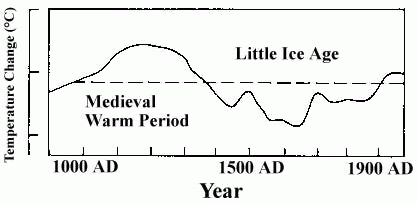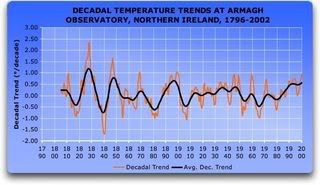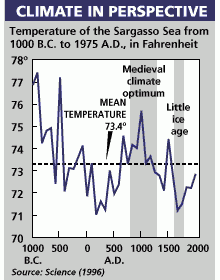For an example, the World Data Center for Paleoclimatology (paleoclimatology is the study of climate change taken on the scale of the entire history of the Earth) flatly states that existing records show there was no multi-century periods when global or hemispheric temperatures were the same or warmer than in the 20th century.
The World Data Center conclusion dismisses the widely accepted science that confirms the existence of a Medieval Warm Period (approximately AD 800-1300) based on acceptance of the conclusions of the now discredited Mann et al (1999) study that fathered Al Gore’s ‘hockey stick.’
Critical analyses of the methodology used to create the ‘hockey stick’ graph, and comparisons to hundreds of global studies of the period, showed it was a bastard offspring of science resulting from the rape or forced marriage of two unrelated data bases.
This sentence in the Mann et al study Abstract pretty much sums up its low scientific worth towards gaining an understanding of the present compared to the Medieval Warm Period.
Though expanded uncertainties prevent decisive conclusions for the period prior to AD 1400, our results suggest that the latter 20th century is anomalous in the context of at least the past millennium.
The first part of the sentence says it can’t be sure of climate prior to AD 1400; the second part says nevertheless the latter part of the 20th century was warmer than any in the preceding 1000 years. Can science have it both ways? Can such uncertainty lead to such certainty in conclusions?
The graph below shows the Medieval Warm Period and Little Ice Age in relation to today's temperatures. You can easily see why Al Gore and the Deniers need to kill this information, since it doesn't fit their man-made, carbon dioxide driven, global warming scenario.

As John L. Daly notes, The ‘Hockey Stick’ – A New Low in Climate Science:
Using tree rings as a basis for assessing past temperature changes back to the year 1,000 AD, supplemented by other proxies from more recent centuries, Mann completely redrew the history, turning the Medieval Warm Period and Little Ice Age into non-events, consigned to a kind of Orwellian `memory hole.'
Daly continued:
At that point, Mann completed the coup and crudely grafted the surface temperature record of the 20th century (itself largely the product of urban heat islands) onto the pre-1900 tree ring record. The effect was visually dramatic as the 20th century was portrayed as a climate rocketing out of control. The red line extended all the way to 1998 (Mann's `warmest year of the millennium'), a year warmed by the big El Niño of that year. It should be noted that the surface record is completely at variance with the satellite temperature record. Had the latter been used to represent the last 20 years, the effect would have been to make the 20th century much less significant when compared with earlier centuries.
So there you have it. Al Gore and the Natural Global Warming Deniers excised an earlier warmer period from their study, and graphed to it a temperature record created with a different methodology. A mongrel record, as noted by Daly, that does not even agree with the much more precise and reliable temperature data readily available since 1979 from weather satellites.

Other studies show that natural global warming has resulted in an average increase in global temperature of 0.6° C each century for the past 200 years. Far from the 1990’s and 2000’s to date being the warmest in 1000 years, they're not even the warmest in the past century. The 1930’s and 1940’s have that distinction.

The short term temperature increase in the 1990’s was not the most dramatic in 1000 years. Less than 200 years ago, a much larger increase in temperatures took place in 1819 to 1828.

In the Sargasso Sea, radiocarbon dating of marine organisms in sea bed sediments by L. Keigwin demonstrates that sea surface temperatures were around 2°F cooler than today around 400 years ago (the Little Ice Age), and around 2°F warmer than today 1,000 years ago (the Medieval Warm Period). In addition, the data also demonstrates that the period before 500 BC (the so-called Holocene Climatic Optimum) saw temperatures up to 4°F warmer - and without any greenhouse gas component to cause it.
Al Gore and the Deniers seem to favor science by consensus, rather than by a careful examination of competing claims. In that, they are a lot like historical consensus-based scientists, who at various times held sway with certainty that the Earth was flat, that lack of cleanliness did not cause infections following operations, that man would never fly, and on, and on. In fact, each significant scientific advance appears to have been made in defiance of the consensus of the science community of its time.
A recent Harvard study, 20th Century Climate Not So Hot , of over 240 climate studies (enough for a Gore-ian consensus?) arrived at a conclusion, not a consensus, that:
(T)he 20th century is neither the warmest century nor the century with the most extreme weather of the past 1000 years. The review also confirmed that the Medieval Warm Period of 800 to 1300 A.D. and the Little Ice Age of 1300 to 1900 A.D. were worldwide phenomena not limited to the European and North American continents. While 20th century temperatures are much higher than in the Little Ice Age period, many parts of the world show the medieval warmth to be greater than that of the 20th century.
Al Gore, come out of denial. I know it will be a terrible experience to face the truth after all you’ve preached, but in the end it’s for the best.
Remember, Honesty is the first of the twelve steps, and can begin with one simple admission that you are powerless to prevent the disclosure that natural global warming has been, and will continue to be, the predominant cause of global climate change, just as it has been for over 600 times before.
You’ll feel better for it, once everyone stops laughing.
Just as Paul Ehrlich about “The Population Bomb.”
After almost forty years, most people only snicker at him now.
Please click on the label below to see all my articles on Global Warming.
No comments:
Post a Comment